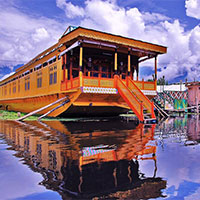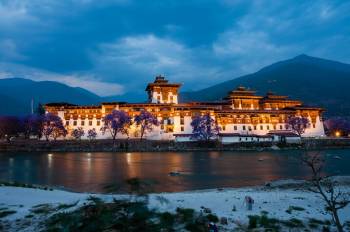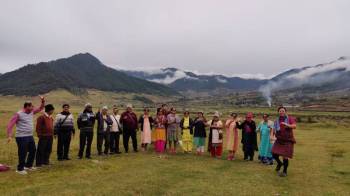7 Nights / 8 Days

Return Airfare
Items of personal nature like laundry, telephone calls, room service charges, soft drinks and hard drink charges, etc
Any service not mentioned in Inclusions.
The payments for additional services taken at the hotel are to be settled directly at the hotel.
Govt. service tax extra as applicable
Guide and entrance charges during sightseeing
Once you arrive in Paro, you will be received by our representative and guide who will transfer you to your hotel in Thimphu. Thimphu: Capital to the tiny Himalayan kingdom of Bhutan, Thimphu is one of the smallest capitals in the world. For most part of its history, Bhutan has tried consciously to save its culture from the influences of the western world. It is not that modernity has not reached this region, but is being introduced in a phased and balanced manner that is unheard of at any place in the world. All these make Thimphu and other parts of the country a unique destination. Upon arrival, proceed for check-in at your hotel. After taking rest for some time take a tour of the town. Trashi Chhoe Dzong: Also called Fortress of the Glorious Religion, it is situated north of the city on the west bank of the Wang Chhu. The Dzong was the site of the lavish formal coronation of the fifth King in 2008 and hosts the city’s biggest annual bash, the colorful tsechu festivities. National Library: Housing an extensive collection of priceless Buddhist manuscripts; the Institute for Zorig Chusum (commonly known as the Painting School) is where students undergo a 6-year training course in Bhutan’s 13 traditional arts and crafts. Spend rest of the evening at leisure and enjoy a warm dinner before you go to bed.
After breakfast, proceed for sightseeing. Buddha View Point: Another place from where you can get a good overview of the Thimphu valley is from the Buddha Point (Kuensel Phodrang). You can pay your obeisance and offer prayers to the Buddha Statue, the largest in the country and then walk around and take a glimpse of the valley.
Simtokha Dzong: The monastery was built in 1627 by Zhabdrung Ngawang Namgyal. It houses the Institute for Language and Cultural Studies. The carvings behind the prayer wheel in the courtyard are a major attraction of this temple.
Memorial Chorten: It is also known as the Thimphu Chorten, and is located on Doeboom Lam in the southern-central part of the city near the main roundabout and Indian military hospital.
Textile Museum: It is worth a visit to get to know the living national art of weaving. Exhibitions introduce the major weaving techniques, styles of local dress and textiles made by women and men.
Takin Mini Zoo: The Takin is the national animal of Bhutan, and looks like a cross between a cow and a goat. Legend has it that the animal was created by the great Buddhist yogi, Drupa Kunley, and it can be found only in Bhutan and nearby areas. In the evening, return to your hotel and rest overnight after a delicious dinner.
After having breakfast, check-out of the hotel and proceed to Punakha. On the way to Punakha you will go through the Dochula Pass. Stop at Dochula View Point which is the first stop after leaving Thimphu. About 45 minutes from Thimphu, it offers visitors their first glimpse of the Himalayan range. The road to Punakha branches left and curls its way down to the relatively low lands of the Punakha valley. On arrival, check-in at the hotel and have lunch (on direct payment basis). Later, go for sightseeing.
Punakha Dzong: Majestically standing on an island between the confluence of the Pho Chhu and Mo Chhu rivers, the city's dzong is one of the most photogenic of all Bhutan's ancient fortresses, and you will see pictures of it hanging in hotels and restaurants throughout the country. The dzong is joined to the mainland by an arched wooden bridge and contains many precious relics from the days when successive kings reined the kingdom from this valley.
Chimi Lhakhang (Fertility Temple): Situated on a hillock in the centre of the valley below Metshina is the yellow-roofed Chimi Lhakhang, built in 1499 by the cousin of Lama Drukpa Kunley in his honour after he subdued the demoness of the nearby Dochu La with his ‘magic thunderbolt of wisdom’. A wooden effigy of the lama’s thunderbolt is preserved in the lhakhang and childless women go to the temple to receive blessings from the saint. It’s a pleasant 20-minute walk across fields from the road at Sopsokha to the temple. You will cross an archery ground before making a short climb to the temple.
In the evening, return to your hotel and enjoy a comfortable overnight stay.
After an early breakfast, drive from Punakha to Phobjikha. Visit Wangdiphodrang Ruin Dzong, perched on a promontory, 13 kilometres from Punakha. The Dzong was built in 1638 A.D and holds great historical importance. Drive to Phobjikha valley following the highway to Nobding, at a distance of 40 kilometres. From here you will divert onto a 13-kilometre unpaved track crossing over the Gangtey Pass (3140 m), and then drop into the Phobjikha Valley. Phobjikha Nature Hike. The hike starts below Gangtey Goemba. The first part of the walk is downhill, for about 30 minutes, to the Khewa Chu stream that meanders through Phobjikha valley. From Khewa village, the trail leads through open meadows to the Khewa Lhakhang built in 13th century. The temple houses about 30 young monks. Take this opportunity to meet with the Khenpo, head of monastery, and enjoy a cup of tea. Take a short hike to the village of Gophu and visit a Bhutanese farm house for an authentic Bhutanese style lunch (own expense). The walk will end at the village school before reaching the Phobjikha village town. Spend the afternoon exploring the Phobjikha village or visit Gophu village and return to your hotel in Punakha in the evening for a sumptuous dinner and comfortable overnight stay.
After breakfast this morning, check-out of the hotel and proceed to Paro. Upon arrival in Paro, check-in at the hotel and have lunch (on direct payment basis). Later, go for sightseeing. Drukgyal Ruin Dzong: Originally a fortress and Buddhist monastery, it is now in ruins and is located in the upper part of Paro valley. The Dzong was built by Tenzin Drukdra in 1649 at the behest of Shabdrung Ngawang Namgyal to commemorate victory over an invasion from Tibet. In the early 1950s Drukgyal Dzong was almost completely destroyed by fire. Kyichu Lhakhang: Built in 659 by the Tibetan King Songtsen Gampo; it is believed to be one of the 108 temples built to subdue a demoness residing in the Himalayas and is also one of the oldest temples in Bhutan. In the evening, return to your hotel and rest overnight after a delicious dinner.
After having breakfast at the hotel, either go for an excursion tour to Chele La Pass and Haa Valley or hike up the hill to visit the famous Tiger’s Nest temple and spend rest of the evening in the local market.
Chele La Pass and Haa Valley: At over 13,000 ft to the west above the Paro Valley is the highest road pass in the country and has amazing views of the Himalayas and most significantly the magnificent Jhomolari, Bhutan's most sacred peak at over 22,000 feet. It is a one and a half hour drive from the valley floor in Paro to the pass. The views from here are absolutely mind boggling as the sweep of the snow clad Himalayas lay before you. Spend the evening at leisure in Paro town for some souvenir shopping and get a feel of the city.
Taktsang Monastery (Tiger’s Nest Temple): The most famous of Bhutanese monasteries, it is said that Guru Rinpoche arrived here on the back of a tigress and meditated at this monastery hence it is called Tiger’s Nest. Precariously perched on the edge of 1,200 meter cliff, this monastery creates an impressive sight, and is the unofficial symbol of Bhutan. It is about 2-hour up-hill hike or ride a horse from the parking lot to the monastery. If the full hike sounds a bit tough you can hike for 1 hour to the cafeteria, a wooden tea-house restaurant which offers a good view of the monastery. After visiting the monastery spend the evening at leisure in Paro town for some souvenir shopping and get a feel of the local Paro town. In the evening, return to your hotel, enjoy your dinner and a comfortable overnight stay.
After having breakfast at the hotel visit Bhutan’s most impressive and well known Dzong, perhaps the finest example of Bhutanese architecture you will see.
Rinpung Dzong: It is a fortress-monastery that serves both as a civil administrative center and as a monastic home for a community of monks. Most dzongs were built in the mid-1600s to protect the inhabited valleys from invasion by Tibet. The Paro Dzong was started in 1644 on the order of Shabdrung Ngawang Namgyal, the unifier of modern day Bhutan. Unlike most of the Dzongs in Bhutan, it survived the massive 1897 earthquake mostly unscathed, though it was damaged by fire in 1907.
National Museum of Paro: Housed inside the revamped Ta-dzong building in Paro, National Museum of Bhutan is a cultural museum that has put on display the antique items gathered from different parts of the country. Spend the evening at leisure wandering around Paro town for some souvenir shopping and to get a feel of the city. Enjoy your dinner and a comfortable overnight stay.
After breakfast this morning, you will be transferred to Paro Airport to board your flight back.
We deals in Airline Ticketing, Rail Ticketing, Passport services, Tour Operators, Hotel Booking, Bus Ticketing Services. Read More...
 5D/4N
5D/4N
 6D/5N
6D/5N
 7D/6N
7D/6N
 9D/8N
9D/8N
Jammu - Katra - Srinagar - Pahalgam - So..
Jammu - Srinagar - Pahalgam - Sonamarg - Gulmarg
 6D/5N
6D/5N
 11D/10N
11D/10N
Kashmir - Sonmarg - Gulmarg - Pahalgam -..
Kashmir - Gulmarg - Sonamarg - Leh Ladakh - Leh Leh Ladakh
 8D/7N
8D/7N
Katra, Patnitop, Srinagar, Gulmarg, Paha..
Srinagar - Gulmarg - Pahalgam - Sonamarg - Jammu
 4D/3N
4D/3N
 4D/3N
4D/3N
 8D/7N
8D/7N
 8D/7N
8D/7N
 8D/7N
8D/7N
 8D/7N
8D/7N
 8D/7N
8D/7N
 8D/7N
8D/7N
 8D/7N
8D/7N
 8D/7N
8D/7N
 8D/7N
8D/7N
Delhi Shimla Manali Honymoon Package
New Delhi - Shimla - Manali - Chandigarh City
 5D/4N
5D/4N
 7D/6N
7D/6N
6 Nights/ 7 Days - Bhutan Happiness Tour
Punakha - Bumthang - Paro - Thimphu - Phobjik
 7D/6N
7D/6N
6 Night 7 Day Wonderful Bhutan Tour
Thimphu - Paro - Wangdue Phodrang - Punakha
 7D/6N
7D/6N
 20D/19N
20D/19N
20 Days Land Package Country Tour Bhutan..
Punakha - Paro - Phuntsholing - Bagdogra - Bumthang - Mongar - Trashigang - Trongsa..
 4D/3N
4D/3N
 6D/5N
6D/5N
 7D/6N
7D/6N
 7D/6N
7D/6N
Rimso 7 Days 6 Nights Bountiful Tour fo..
Thimphu - Punakha - Paro - Phuentsholing